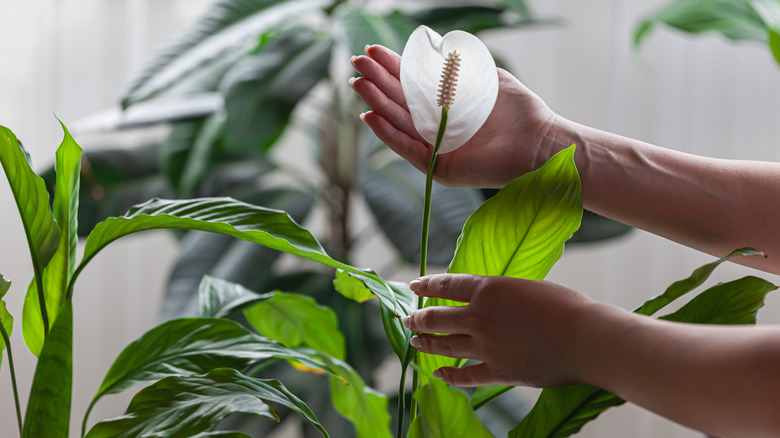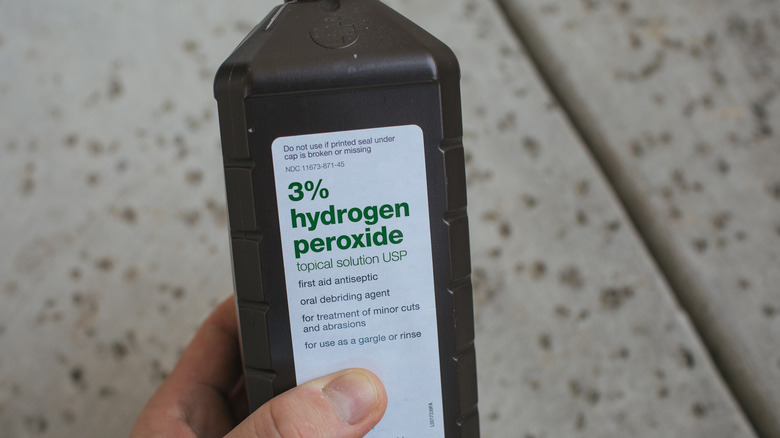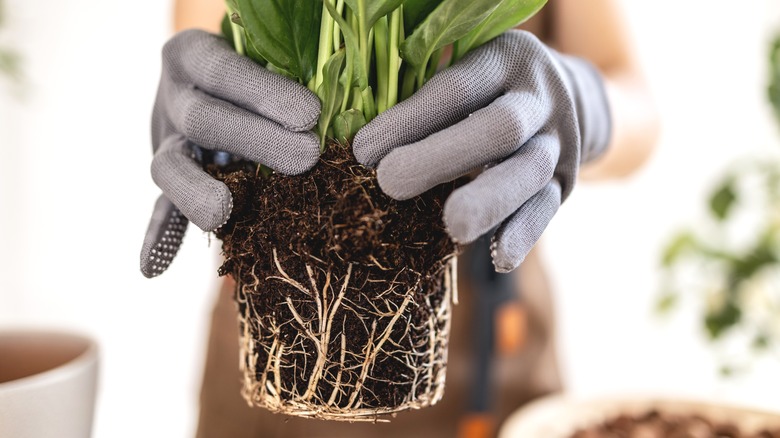Take Extra Caution When Using Hydrogen Peroxide To Treat Root Rot On Peace Lilies
Fewer plants can brighten up a space with pure simplicity like a peace lily can. This white flowered, semi-evergreen perennial herb is often grown as a houseplant. The plant can't talk, but you'll know when it's unhappy because its foliage will wiltat the first sign of dehydration. On the other hand, the peace lily can receive too much water and won't be content with that either. In fact, overwatering a peace lily can contribute to root rot. Wilting, stunted growth, and yellow leaves despite the soil being moist can hint that root rot is afoot, and it's one of many telltale signs your peace lilies are in trouble.
If you're wondering what root rot is, know that it's a plant disease that takes place when a pathogen, namely soil-borne fungi, causes a plant's root system to tank. The disease can be chronic or acute and is a common occurrence in peace lilies. A popular recommendation to treat root rot in peace lilies is hydrogen peroxide, but apply it carefully because the chemical solution can burn your peace lilies' flowers and foliage. The damage from hydrogen peroxide to your peace lily can be avoided by using the chemical in low concentrations and applying hydrogen peroxide to the roots of the peace lily as a spray. This way, your peace lily remains unharmed and root-rot-causing fungus won't stand a chance.
How does hydrogen peroxide treat root rot?
Don't let the bubbly fizz that accompanies an overpour of hydrogen peroxide scare you too much. The odorless fluid is safe for peace lilies at certain concentrations and when applied to the roots of the plant. The typical concentration of hydrogen peroxide for household items and bleaching agents ranges from 3% to 9%. Therefore, the lower the concentration, the gentler the chemical will be on your plants.
At low concentrations, the chemical's use as a fungicide can't be beat. As a spray, the solution's antiseptic properties effectively eliminates bacteria and fungus from the plant's roots so you can repot your peace lily knowing rotting roots will be a thing of the past. Just be sure to only apply the spray to the roots — peace lilies are particularly sensitive to chemicals, and hydrogen peroxide can burn its foliage and blossoms, especially if used at high concentrations.
How to make and apply a hydrogen peroxide spray to treat root rot in peace lilies
Making a hydrogen peroxide spray to combat root rot in your peace lily can be done with a few household items: a spray bottle, 3% hydrogen peroxide, a funnel, measuring cups, measuring spoons, and water. Make your spray by pouring hydrogen peroxide and water through a funnel and into a spray bottle at a ratio of 1 tablespoon of hydrogen peroxide to 1 cup of water. When you're ready to apply the spray to your peace lily, remove the plant from its pot. Separate the infected soil from the root ball and get rid of any rotted roots, while leaving the healthy ones intact. Rot infested roots will appear brown or black, mushy, and they can even smell bad.
You may need to use a hose to wash off the soil more easily and snip off any dying roots with sterilized scissors. Once the plant's roots are cleaned up, spray the hydrogen peroxide on the remaining roots. To replant your peace lily, you have two options. The first is to disinfect your current pot with bleach and replant the peace lily in it. The second is to replant the peace lily in an entirely new pot. Both of these measures are done to reduce the risk of reinfecting the plant with the rot-causing fungus.


